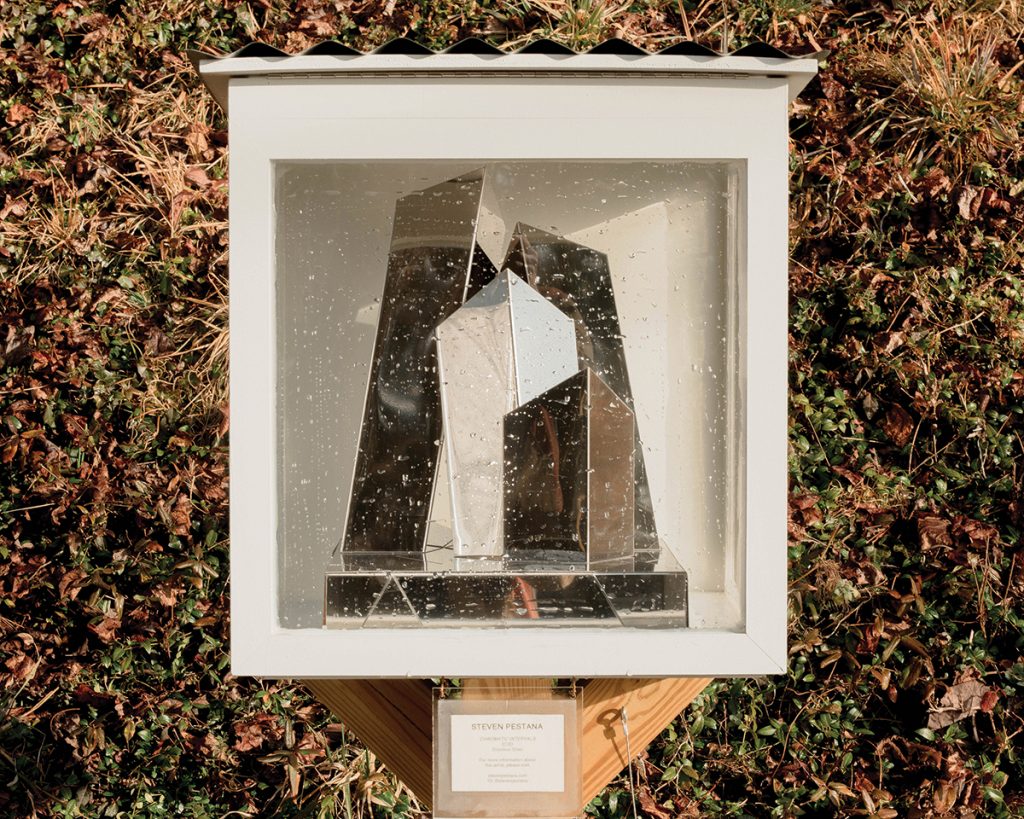
Art instructors Jackson Martin, left, and Suzanne Dittenber knew there had to be a way to get art to the people during a pandemic, so they collaborated on mini front-yard installations with local painter Luke Whitlatch, right.
Photo by Clark Hodgin
Jackson Martin is a contrarian: He believes rules beget innovation rather than stifle it. “Parameters are something I give my students all the time,” says Martin, an associate art professor at UNCA. “These guidelines offer direction and evoke creativity.”
It was this notion that inspired Martin to partner with his artist colleague Suzanne Dittenber — an assistant professor of painting at UNCA — and local painter Luke Whitlatch to install five, four-square-foot al fresco art-viewing boxes in residential areas around Asheville. Made of plywood, plexiglass, and corrugated metal, the boxes are like little roadside libraries. Except, instead of books, the kiosks showcase the work of well-known national artists, including Steven Pestana of Brooklyn and Eric Tillinghast of Los Angeles.
“It’s such a small space that the artists must get inventive,” says Martin, who knows firsthand. His pieces “40 Hour Workweek” and “Coffee Maker” were featured last June. The former is a composition of 300 hand-cut pieces of vinyl fabric that reflect the dimensions of a cinderblock. The latter was part of Making Amends, an ongoing series where Martin spends “absurd amounts of time and materials” fixing cheap, disposable items like Dollar Store coffee pots with broken carafes.
Martin, whose yard is home to one of the art kiosks, says the boxes are an “avenue for creative output” during COVID-19. In fact, the project grew out of Yardwork, a multi-site, socially-distanced outdoor exhibit sponsored by Tiger Strikes Asteroid Greenville, a network of artist-run spaces. As members of the quirkily named collective, Dittenber and Whitlatch decided their contribution to Yardwork would be bijou booths scattered across Asheville.
In May 2020, the two approached Martin via e-mail, asking if he might be interested in creating the boxes. “My initial response was to pass because I had just finished a challenging semester,” he admits. As an instructor of sculpture, he was tasked with teaching three-dimensional art online when UNCA transitioned to remote learning. “Then we had a Zoom conversation, and I just got really excited. I spent the next 24 hours designing the boxes on the computer, which isn’t like me. I’m more of a pencil-and-paper kind of artist.”
Above all, the pandemic has illustrated that we are all capable of evolving, even if in subtle ways. Maybe that’s why Martin took on the task despite his initial reluctance — he realized the project could change his neighbors’ assumptions about art.

Photo by Clark Hodgin
“Galleries and museums are avoided by people because they are worried they won’t ‘get’ fine art,” says Martin. “But by taking art out of the white box and putting it in the environment, we can reach a wider range of people.”
Whitlatch echoes a similar sentiment. Since the viewing boxes are installed in front yards — most participating homeowners are UNCA professors or people associated with Asheville Art Museum — the art is easily accessed by passersby. “Maybe you aren’t necessarily invested or even interested in art, but you are out walking your dog,” proposes Whitlatch. “After seeing the box four or five times, you start to think about the work differently.”
Though the installations are locked with a small hasp, they beg for interaction. Hoping to engage the viewer, Georgia cross-disciplinary artist MaDora Frey incorporated bits of mirror into her installation. Her intention, she writes, was to “reflect the immediate surroundings which are homes, yards, and a bit of nature.” By proximity, the viewer is integrated into the installation as well.
In a sheer coincidence, Pestana also used reflective and geometric materials in his piece, “Chromatic Intervals,” as did Sophia Sobers in her installation. In return, “the works almost have conversations with each other, in this unconscious way,” says Whitlatch.
What Dittenber describes as an “organic, curatorial vision” will continue to shift as different creatives come out of the woodwork. So far, the content of the boxes has changed every two to three months, with each box featuring a different artist. March will be the first time a single artist —Baltimore’s Liz Scofield, who majors in fantastical multimedia sculptures — is featured in all Asheville locations.
“The concept behind this whole project is super simple,” says Whitlatch. “Of course, it’s about providing spaces to show work during the pandemic, but it’s also about having a little moment to stop and look. It’s like stopping to smell the flowers.”
Or, in Martin’s case, stopping to ponder the broken coffee pot.
Art Boxes can be found at 76 Gertrude Place, 135 Lookout Drive, 65 Kenilworth Road, 74 Tacoma Circle, and 30 Virginia Ave. in Asheville. For more information on Tiger Strikes Asteroid Greenville, visit tigerstrikesasteroid.com.